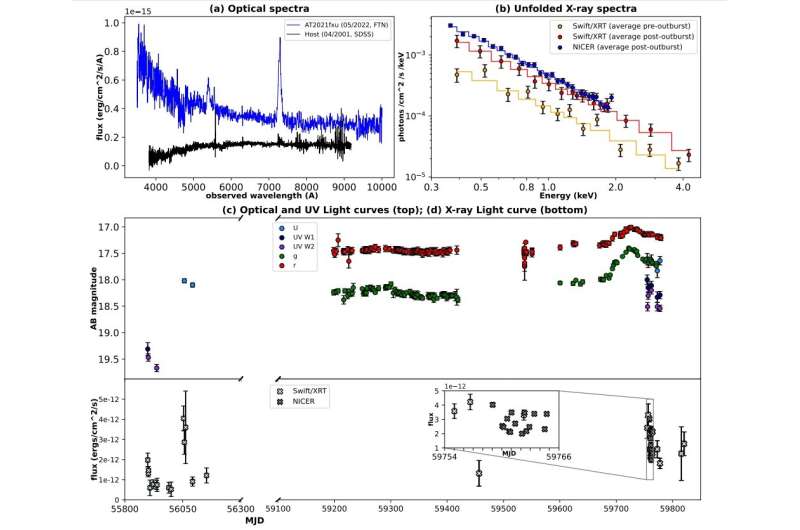December 22, 2022 report
AT2021fxu is a changing-look active galactic nucleus, observations find

By analyzing the data from NASA's Swift spacecraft and from the Neutron Star Interior Composition Explorer (NICER) onboard the International Space Station, astronomers have investigated an active optical transient known as AT2021fxu. Results of the study, published December 14 on the arXiv preprint server, deliver important insights into the nature of this transient, revealing that it is a changing-look active galactic nucleus.
An active galactic nucleus (AGN) is a compact region at the center of a galaxy, more luminous than the surrounding galaxy light. They are very energetic due either to the presence of a black hole or star formation activity at the core of the galaxy.
Astronomers generally divide AGNs into two groups based on emission line features. Type 1 AGNs show broad and narrow emission lines, while only narrow emission lines are present in Type 2 AGNs. However, observations revealed that some AGNs transition between different spectral types—they are known as changing-look (CL) AGNs.
At a redshift of approximately 0.11, AT2021fxu (other designations: ZTF21aalxxzn and Gaia22dgm) is an optical transient identified during an outburst by the Zwicky Transient Facility (ZTF) on February 13, 2021. Some studies have suggested that it may be a CL AGN.
Recently, a team of astronomers led by Yukta Ajay of the Indian Institute of Science Education and Research (IISER) in Tirupati, India, took a closer look at AT2021fxu hoping to disclose its true nature. For this purpose they inspected the available multiwavelength data from Swift and NICER.
"Here we present analysis of AT2021fxu's multiwavelength data taken over a temporal baseline of over two decades," the researchers wrote in the paper.
By analyzing the optical, ultraviolet and X-ray data, the astronomers found that the optical spectrum of ZTF21aalxxzn clearly shows the appearance of broad emission lines (BELs). This suggests that the source underwent a spectral transition from a Type 2 to a Type 1 AGN, during which the brightness in the individual photometric bands increased up to approximately 0.6 mag in the optical bands and up to about 1.1 mag in the ultraviolet bands.
Furthermore, the optical g- and r- magnitudes of ZTF21aalxxzn have remained constant between May 2000 and July 2021. This finding indicates that the optical spectrum of ZTF21aalxxzn remained the same during the mentioned period, and that the recent optical outburst marks the onset of the CL transition in this AGN.
The X-ray spectral analysis of ZTF21aalxxzn found that there is minimal variation in the column density over the observed time. This result suggests that the CL transition is due to a variable accretion rate. Therefore, the authors of the paper concluded that AT2021fxu experienced an accretion-drive CL transition, in which the increase in the ionization flux is able to produce strong broad Balmer lines that drives the change in spectral classification.
More information: Yukta Ajay et al, A Multiwavelength study of the ongoing Changing-look AGN AT2021fxu, arXiv (2022). DOI: 10.48550/arxiv.2212.07272
Journal information: arXiv
© 2022 Science X Network



















